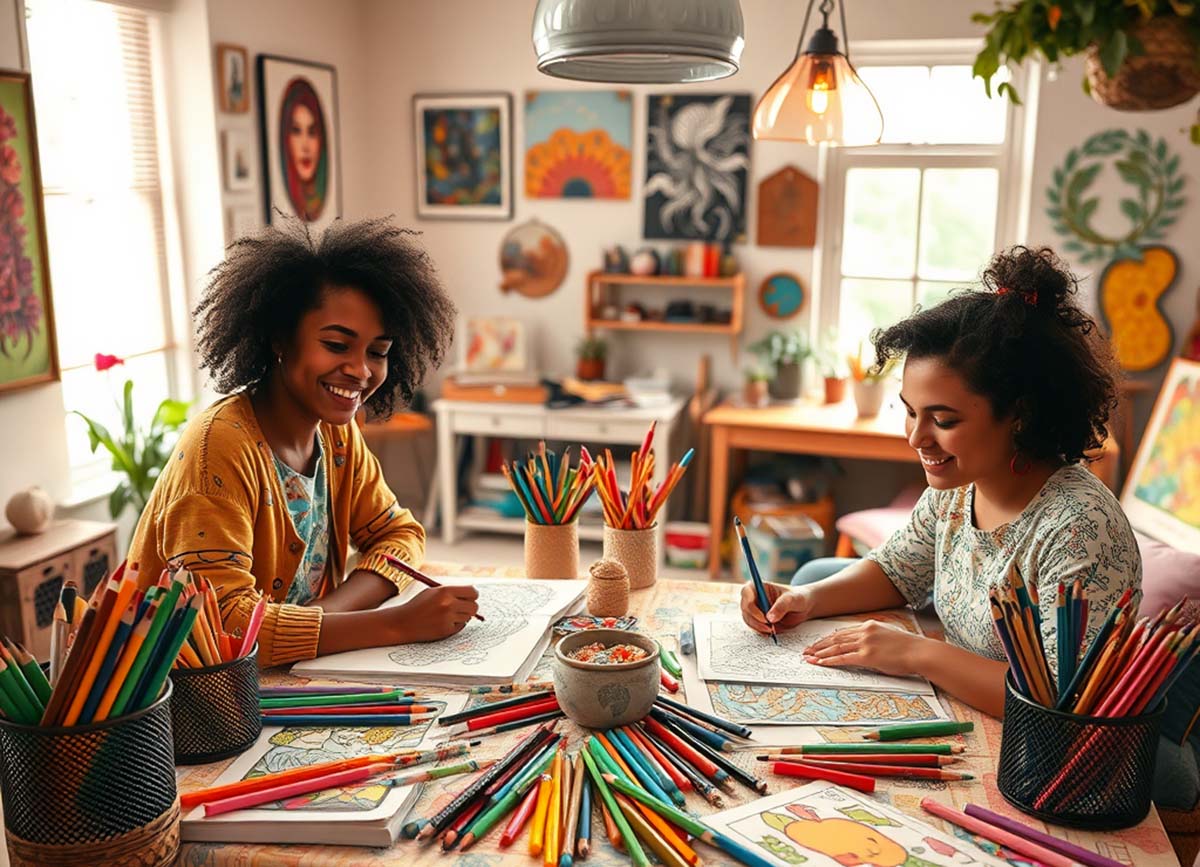
A powerful spark ignites when coloring pages become a gateway to creative expression. Art enthusiasts from every generation find joy in applying vibrant hues while experimenting with styles that soothe nerves and sharpen focus. This piece unfolds layers of therapeutic benefits, historical narratives, and inventive techniques that uplift artistic journeys. Readers will encounter accounts of methods spanning eras, ideas for daily creative practices, and pointers for turning a simple pastime into a fulfilling ritual.
Exploring the Creative Benefits of Coloring
Coloring engages minds and lifts spirits. Personal moods transform when vivid lines merge with imaginative strokes. Creative activity nurtures calm confidence while offering respite from everyday tension. Many report that mixing shades brings clarity and optimism. Experiences span young learners, busy professionals, and seniors seeking renewed zest. For children, coloring not only enhances cognitive skills but also lays the foundation for artistic growth. Many young creatives develop their passion for art through early coloring experiences, which can later evolve into more refined artistic pursuits. This process plays a key role in nurturing young artists, helping them build confidence and explore their unique styles over time.
Psychological relief appears when challenges vanish amid colorful adventures. Emotional burdens lighten as creative energies flow freely. Minds regain focus while artistic ventures open new corridors for inspiration. Individuals who add color to designs often note enhanced mental agility and deeper emotional connections. Vibrant journeys through hues encourage playful experimentation, foster self-expression, and develop skills that reverberate in diverse aspects of life.
Varied age groups benefit from coloring routines. Youth engage with imaginative shapes that stimulate early cognitive skills. Mature participants find renewed energy through tactile interaction with media. Both share rewarding satisfaction as their work reflects personal stories, inviting genuine pride in achievements.
Artistic Techniques and Inspirations
Traditional vs. Modern Methods
Historical tools and current innovations intertwine to shape creative processes. Classic instruments such as pencils, pastels, and markers offer tactile feedback that inspires confidence. Handmade paper and textures invite slow exploration and deliberate decisions. In contrast, digital solutions and apps present streamlined processes with adjustable palettes and virtual brushes that mimic real strokes. Each method carries distinct advantages while inviting diverse perspectives. Analog practices allow natural imprecision that fuels personal style; digital techniques provide precision and endless experimentation without material waste. Artists often find that toggling between these approaches opens new avenues of self-expression.
Contemporary enthusiasts experiment with mixed media by integrating hand-drawn elements with digital overlays. Techniques once confined to studio walls now travel across screens, allowing instant sharing and collaboration. Variations in tools spark fresh inspiration while opening dialogues between tradition and modernity. Artisans worldwide embrace both tactile materials and electronic devices, each contributing unique textures and innovative outcomes.
Integrating Art into Daily Life
Everyday schedules may incorporate small creative rituals that soothe busy minds. Individuals establish dedicated moments for color studies, even during fleeting breaks. Urban dwellers, office professionals, and homemakers alike embrace mindful sessions that ignite inner visions. Simple exercises such as setting aside quiet minutes for sketching or filling blank spaces with hues nurture a habit of creative mindfulness.
Practical hints include selecting portable media that fit travel bags or office drawers, ensuring spontaneous opportunities for creative expression. Environments transform when one introduces organized spaces for art supplies. Imagery boards, ambient lighting, or modest easels in a corner evoke calm energy. Visual aids like infographics and sketches enrich tutorials available via mobile screens, inspiring art practices during commutes or restful pauses. Daily coloring becomes a cherished habit that bolsters self-assurance while crafting visual narratives that reflect personal experiences.
A Journey Through the History and Evolution of Coloring
Centuries-old traditions infuse modern practices with meaning. Ancient civilizations used pigments for ritualistic designs that told stories of divine connections and nature’s bounty. Over time, patterns evolved into decorative art, appearing in manuscripts, ceramics, and textiles. Histories recorded in vibrant frescoes and ornamental designs speak of cultures that revered color as a medium for spiritual expression.
Medieval artisans employed intricate designs to illustrate mythic lore and local legends. Later, popular printed materials brought coloring into common households, democratizing art and encouraging self-expression. Small studios and local workshops thrived, offering techniques that blended craftsmanship with personal narratives. Cultural evolutions demonstrate that adding color to life constitutes a universal language that bridges gaps between eras. Sidebars highlighting historical milestones emphasize how traditions persist in modern contexts while remaining adaptable and relatable.
Modern creative therapy emerged as a respected practice after years of scholarly research. Studies support that engaging with art provides emotional relief and promotes cognitive growth. Historical narratives interlace with contemporary experiences, offering evidence that coloring functions as a timeless catalyst for well-being. Case studies from art therapists, community workshops, and personal memoirs illustrate how artistic endeavors bring balance to lives burdened by stress. Readers encounter a timeline of practices that invite both introspection and communal connection, linking past accomplishments with present creativity.
Embracing Modern Trends in Artistic Expression
Fresh techniques and current approaches redefine visual storytelling. Artists now fuse classical imagery with contemporary innovations. Digital tools simplify intricate processes while providing dynamic options for customization. Online communities generate shared inspiration, encouraging cross-cultural exchanges. Modern practitioners harness technology to transform simple activities into collaborative exhibitions that extend beyond physical boundaries.
Innovative coloring practices gain momentum as creative hubs emerge in unexpected spaces. Public installations and interactive events celebrate art that challenges conventional boundaries. New media art, often rendered via advanced software, invites participation and transforms passive viewing into hands-on experimentation. This wave of modern trends blurs distinctions between professional artistry and personal hobby, fostering environments where diverse voices contribute to a mosaic of visual expression.
In creative studios and informal gatherings alike, techniques combine traditional methods with current flair. Mobile applications, interactive tutorials, and virtual galleries populate spaces once reserved for physical exhibitions. Artistic expressions move beyond confined frames, resonating in digital platforms that celebrate visual communication. Shared passions unite practitioners who relish both legacy practices and the latest advances, ensuring that creative expression continues to evolve while preserving cherished heritage.
Tips and Techniques for an Enriched Coloring Experience
Practical advice helps art enthusiasts progress with confidence. Beginners may start with broad strokes and gradually refine details. Experienced colorists experiment with layering hues to produce nuanced textures and subtle transitions. Consistent practice nurtures skills that become evident with time. Select quality materials that suit personal preferences; invest in supplies that offer lasting vibrancy. Maintain variety by alternating between tools to prevent monotony and encourage fresh perspectives.
Guidance exists in structured exercises that encourage risk-taking and deliberate experimentation. Many practitioners recommend daily sessions, even if brief, to develop a robust creative routine. Routine experimentation proves beneficial when combining different media, encouraging unexpected results that surprise and satisfy. Occasional challenges push creative boundaries; tasks such as limiting color palettes or creating pieces without traditional outlines develop resourcefulness and inventiveness. Techniques become personalized as individuals tweak approaches to align with moods and environments.
Social platforms offer opportunities for artistic exchange and constructive critique. Shared experiences inspire additional creativity and help refine techniques over time. Virtual forums, local clubs, and workshops nurture supportive networks that foster growth. Readers participate in discussions, share snapshots of finished work, and offer suggestions that generate communal pride in individual achievements. Such engagement transforms solitary practice into a vibrant dialogue that fuels continuous artistic improvement.
Commitment to continuous learning ensures that skills advance steadily. Experimenting with new textures, diverse tools, or even unconventional surfaces often yields surprising breakthroughs. Suggestions from seasoned practitioners and educators add depth to individual styles. Creativity flourishes when one views every piece as a chance to push personal limits and celebrate progress, regardless of perfection. Tips and techniques meld with personal intuition, paving pathways to enriched artistic journeys that brighten both canvas and spirit.

